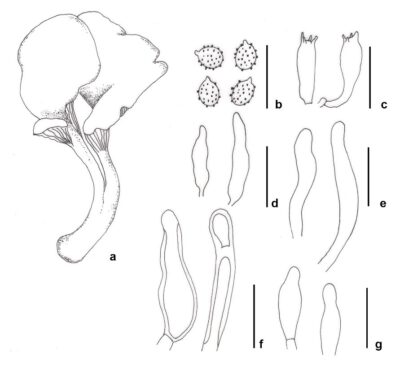Fungalpedia – Note 202, Lentinellus
Lentinellus P. Karst.
Citation if using this entry: Bera et al. 2024 (in prep) – Fungalpedia, Basidiomycota 1.
Index Fungorum, MycoBank, Facesoffungi, GenBank, Fig. 1
Classification: Auriscalpiaceae, Russulales, Agaricomycetes, Basidiomycota, Fungi.
Lentinellus, the lamellate agaric belongs to Auriscalpiaceae Maas Geest., is primarily known for its white rot and wood decay properties. Initially, the genus was placed under the tribe Leucopaxilleae of the Tricholomataceae R. Heim ex Pouzar family (Segedin 1996). Later, based on the shared affinities with Auriscalpium Gray, Maas Geesteranus (1963) proposed the establishment of Auriscalpiaceae, encompassing both genera (Segedin 1996). Lentinellus has a perennial habit defined by its variously shaped, leathery textured basidiomata with a characteristic lacerate margin of lamellae (Segedin 1996). The basidiomata may be laterally or dorsally stipitate, with the surface ranging from smooth to tomentose or sometimes partially hairy (Segedin 1996). Another identifying feature of this genus is the strongly amyloid reaction of verrucose ornamented basidiospores (Segedin 1996). The cystidia structures are usually of two types the lamellar leptocystidia, which are thin-walled, fusiform to ventricose shaped, without any contents, and thick-walled, swollen pseudocystidia with the endings of the oleiferous system (Segedin 1996). The hyphae of pileipellis are in cutis arrangement, reflected in the pileus’s tomentum surface (Segedin 1996). All the trama and context hyphae may be amyloid (Segedin 1996). With all these morpho-characters, Lentinellus is easily recognizable. However, identifying different species can be challenging, and identifying different species can be difficult; thus, many previously described species have been synonymized (Pegler 1983, Segedin 1996).
Lentinellus has often been confused with another wood-decaying genus, Lentinus Fr. Many species (for instance the type species, Lentinellus cochleatus (Pers.) P. Karst. were initially placed under Lentinus by Persoon (1825). However, the status of these two genera was later reviewed by Pegler (1983). The difference in basic morphological characters separated both genera and classified them under different systematic positions (Lentinellus in Russulales and Lentinus in Polyporales). In essence, there is a need for more precise and refined criteria for species differentiation within Lentinellus to address all the taxonomic complexities. The sole use of morphology has often led to considerable taxonomic confusions especially with the similar-looking taxa (Miller & Stewart 1971, Pegler 1983, Segedin 1996, Miller & Methven 2000). McGhee (1999) conducted a comprehensive classification and phylogeny of Northern Hemisphere Lentinellus species with nrITS sequence data. Later, Lickey et al. (2003) showed the variability of nrSSU region in Lentinellus species, paving new advancements in molecular studies within Lentinellus. The distribution of Lentinellus has typically been associated with temperate forested areas worldwide (Segedin 1996), based on the extensive monographs by Pilát (1946), Watling & Gregory (1989), Segedin (1996), and Moreau et al. (1999). Later, Petersen & Hughes (2004) described 24 species of Lentinellus. Currently, as per Species Fungorum (2023), 35 species have been documented under Lentinellus.
Synonyms: Hemicybe P. Karst, Lentinaria Pilát
Type species: Lentinellus cochleatus (Pers.) P. Karst.
Other accepted species: (Species Fungorum – search Lentinellus)
Figure 1 – Lentinellus crawfordii (holotype PDD 59758). a Basidiomata. b Basidiospores. c Basidia. d Leptocystidia. e Lamellar pseudocystidia. f Stipital pseudocystidia. g Pileal pseudocystidia. Scale bars: a = 20 mm, b = 10 μm, c-g = 20 μm. Redrawn from Segedin (1996).
References
Maas Geesteranus RA. 1963 – Hyphal structures in Hydnums II. Proceedings of the Koninklijke Nederlandse Akademie van Wetenschappen, 66, 426–457.
Miller Jr OK, Stewart L. 1971 – The genus Lentinellus. Mycologia, 63(2), 333–369.
Moreau P-A, Roux P & Mascarell G. 1999 – Une étude du genre Lentinellus en Europe. Bulletin trimestriel de la Société Mycologique de France, 115, 279–373.
Persoon CH. 1825 – Mycologia Europaea, 2–214.
Entry by
Ishika Bera, Center of Excellence in Fungal Research, Mae Fah Luang University, Chiang Rai 57100, Thailand
(Edited by Kevin D Hyde, Samaneh Chaharmiri-Dokhaharani, & Achala R. Rathnayaka)
Published online 6 February 2024
